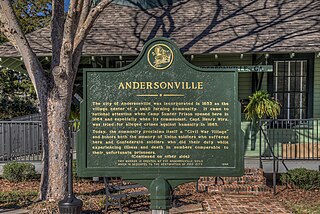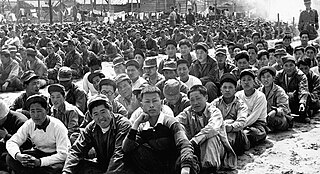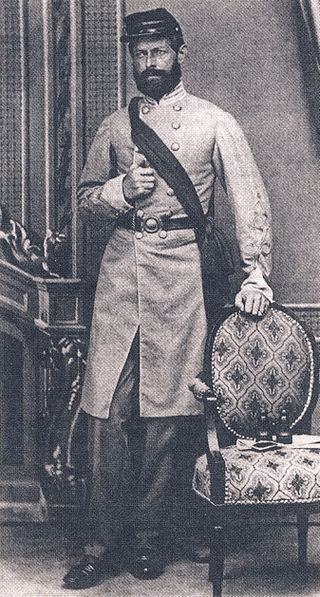
Andersonville is a city in Sumter County, Georgia, United States. As of the 2020 census, the city had a population of 237. It is located in the southwest part of the state, approximately 60 miles (97 km) southwest of Macon on the Central of Georgia railroad. During the American Civil War, it was the site of a prisoner-of-war camp, which is now Andersonville National Historic Site.

A prisoner of war (POW) is a person who is held captive by a belligerent power during or immediately after an armed conflict. The earliest recorded usage of the phrase "prisoner of war" dates back to 1610.

Victor's justice is a term which is used in reference to a distorted application of justice to the defeated party by the victorious party after an armed conflict. Victor's justice generally involves the excessive or unjustified punishment of defeated parties and the light punishment of or clemency for offenses which have been committed by victors. Victors' justice can be used in reference to manifestations of a difference in rules which can amount to hypocrisy and revenge or retributive justice leading to injustice. Victors' justice may also refer to a misrepresentation of historical recording of the events and actions of the losing party throughout or preceding the conflict.

The postage stamps and postal system of the Confederate States of America carried the mail of the Confederacy for a brief period in American history. Early in 1861 when South Carolina no longer considered itself part of the Union and demanded that the U.S. Army abandon Fort Sumter, plans for a Confederate postal system were already underway. Indeed, the Confederate Post Office was established on February 21, 1861; and it was not until April 12 that the American Civil War officially began, when the Confederate Army fired upon US soldiers who had refused to abandon the fort. However, the United States Post Office Department continued to handle the mail of the seceded states as usual during the first weeks of the war. It was not until June 1 that the Confederate Post Office took over collection and delivery, now faced with the task of providing postage stamps and mail services for its citizens.

A prisoner-of-war camp is a site for the containment of enemy fighters captured by a belligerent power in time of war.

Henry Wirz was a Swiss-born American military officer and convicted war criminal who served in the Confederate States Army during the American Civil War.

The Andersonville National Historic Site, located near Andersonville, Georgia, preserves the former Andersonville Prison, a Confederate prisoner-of-war camp during the final fourteen months of the American Civil War. Most of the site lies in southwestern Macon County, adjacent to the east side of the town of Andersonville. The site also contains the Andersonville National Cemetery and the National Prisoner of War Museum. The prison was created in February 1864 and served until April 1865.

Cahaba Prison, also known as Castle Morgan, was a prisoner of war camp in Dallas County, Alabama where the Confederacy held captive Union soldiers during the American Civil War. The prison was located in the small Alabama town of Cahaba, at the confluence of the Alabama and Cahaba rivers, not far from Selma. It suffered a serious flood in 1865. At the time, Cahaba was still the county seat, but that was moved to Selma in 1866. Cahaba Prison was known for having one of the lowest death rates of any Civil War prison camp mainly because of the humane treatment from the Confederate commandant.

Camp Douglas, in Chicago, Illinois, sometimes described as "The North's Andersonville," was one of the largest Union Army prisoner-of-war camps for Confederate soldiers taken prisoner during the American Civil War. Based south of the city on the prairie, it was also used as a training and detention camp for Union soldiers. The Union Army first used the camp in 1861 as an organizational and training camp for volunteer regiments. It became a prisoner-of-war camp in early 1862. Later in 1862 the Union Army again used Camp Douglas as a training camp. In the fall of 1862, the Union Army used the facility as a detention camp for paroled Confederate prisoners.

The Florence Stockade, also known as The Stockade or the Confederate States Military Prison at Florence, was a Confederate prisoner-of-war camp located on the outskirts of Florence, South Carolina, during the American Civil War. It operated from September 1864 through February 1865; during this time, as many as 18,000 Union soldiers were imprisoned there, about 2,800 of whom died.

Camp Chase was a military staging and training camp established in Columbus, Ohio in May 1861 after the start of the American Civil War. It also included a large Union-operated prison camp for Confederate prisoners during the American Civil War.

Andersonville is a novel by MacKinlay Kantor concerning the Confederate prisoner of war camp Andersonville prison during the American Civil War (1861–1865). The novel was originally published in 1955, and won the Pulitzer Prize for Fiction the following year.

Elmira Prison was originally a barracks for "Camp Rathbun" or "Camp Chemung", a key muster and training point for the Union Army during the American Civil War, between 1861 and 1864. The 30-acre (120,000 m2) site was selected partially due to its proximity to the Erie Railroad and the Northern Central Railway, which crisscrossed in the midst of the city. The Camp fell into disuse as the war progressed, but its "Barracks #3" was converted into a military prison in the summer of 1864. It was the prison holding the largest number of Confederate POWs. Its capacity was 4,000, but it held 12,000 within one month of opening. A different source says that Camp Rathbun had a capacity of 6,000 recruits, but that it was turned into a prison for 10,000 and the Union Commissary General was given just 10 days to make it happen.

The Immortal Six Hundred were 600 Confederate officers who were held prisoner by the Union Army in 1864–65. In the summer of 1863, the Confederacy passed a resolution stating all captured African-American soldiers and the officers of colored troops would not be returned. The resolution also allowed for any captured officer of colored troops to be executed and any captured African-American soldier be sold into slavery. The resolution caused a breakdown in the exchange of captured soldiers as the Union demanded all soldiers be treated equally. The Immortal Six Hundred were one group of officers who could not be exchanged.

John Henry Winder was a career United States Army officer who served with distinction during the Mexican–American War. He later served as a Confederate general officer during the American Civil War.
The Andersonville Raiders were a band of rogue soldiers incarcerated at the Confederate Andersonville Prison during the American Civil War. Led by their chieftains – Charles Curtis, John Sarsfield, Patrick Delaney, Teri Sullivan, William Collins, and Alvin T. Munn – these soldiers terrorized their fellow prisoners, stealing their possessions and sometimes even committing murder.

Father Peter Whelan was an Irish-born Catholic priest who distinguished himself as a chaplain for both Confederate troops and Union prisoners of war during the American Civil War. Father Whelan previously served as a missionary in North Carolina and pastor of Georgia's first Catholic parish, and twice served as administrator of the entire Diocese of Savannah.

A parole camp was a place during the American Civil War in which Union or Confederate soldiers on parole could be kept by their own side, in a non-combat role. They could be restored to a combat role if some prisoners of war were traded to the other side. That would enable them to be returned to a combat role as an exchange for the newly-freed prisoners of war. Conditions in the camps were unpleasant; the parolees refused to do guard duty or routine work and claimed that would violate their parole. Many escaped to go home.

Between 1861 and 1865, American Civil War prison camps were operated by the Union and the Confederacy to detain over 400,000 captured soldiers. From the start of the Civil War through to 1863 a parole exchange system saw most prisoners of war swapped relatively quickly. However, from 1863 this broke down following the Confederacy's refusal to treat black and white Union prisoners equally, leading to soaring numbers held on both sides.
Thaddeus Stevens Smith was a soldier from Pennsylvania who fought in the American Civil War. He received the United States' highest medal for bravery during combat, the Medal of Honor, for his actions during the Battle of Gettysburg 2 July 1863. He was issued the medal on 5 May 1900.



















